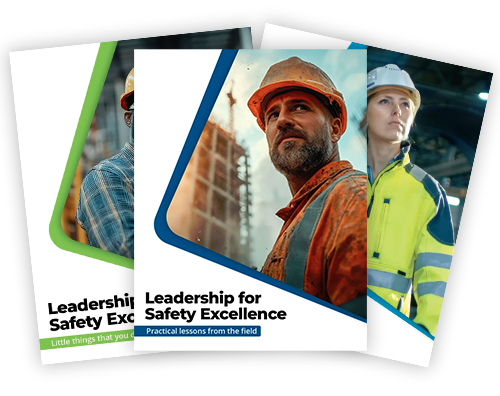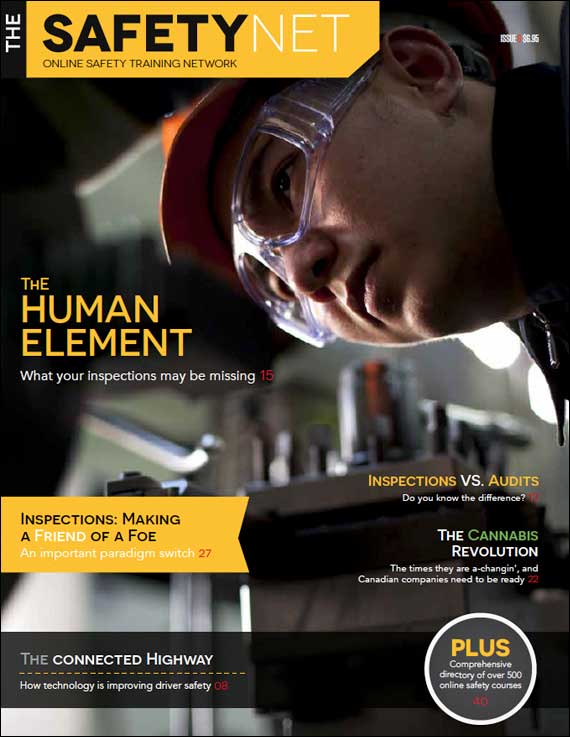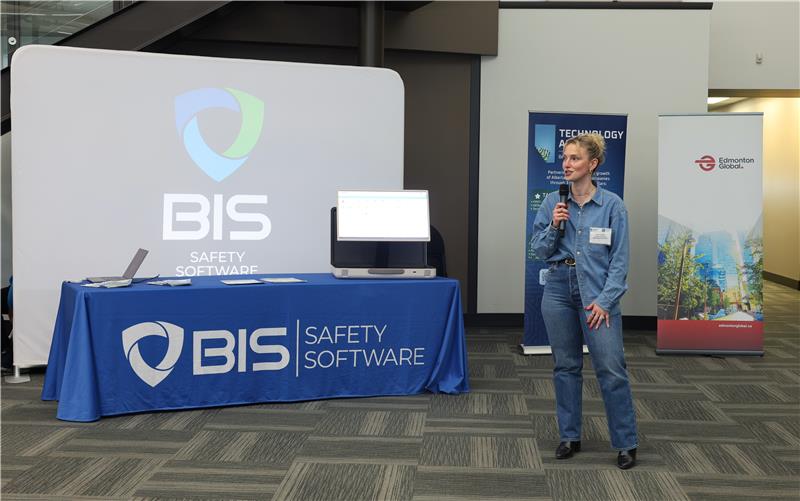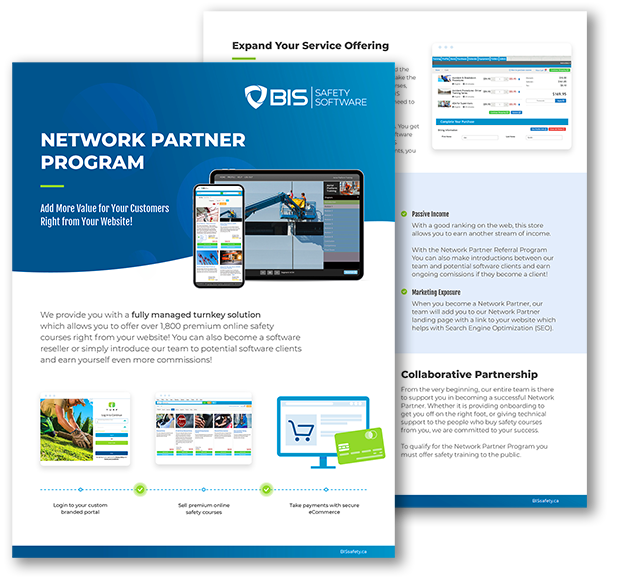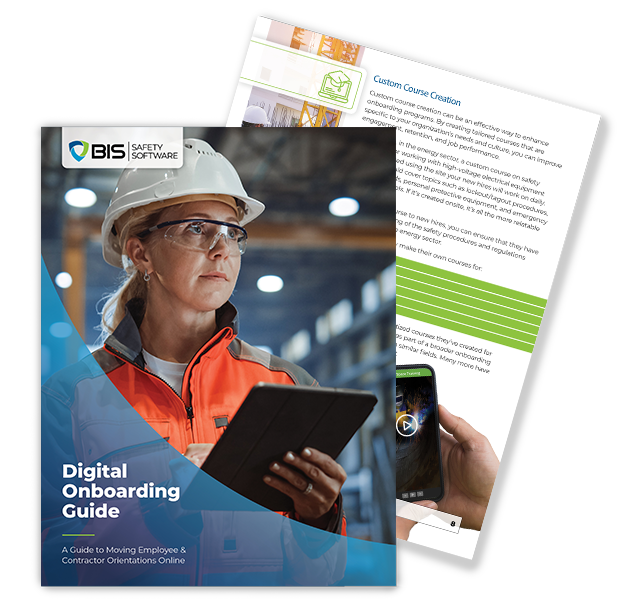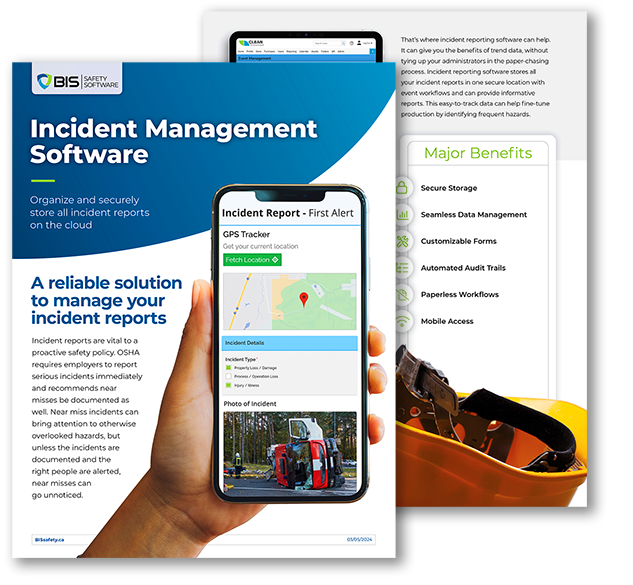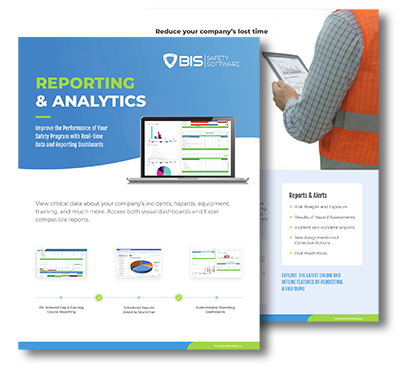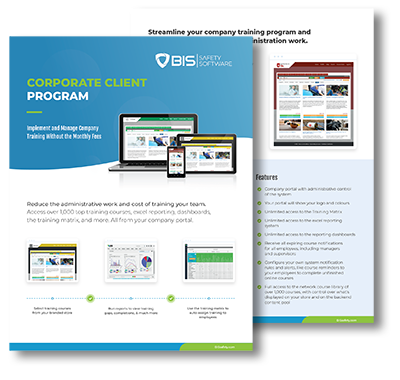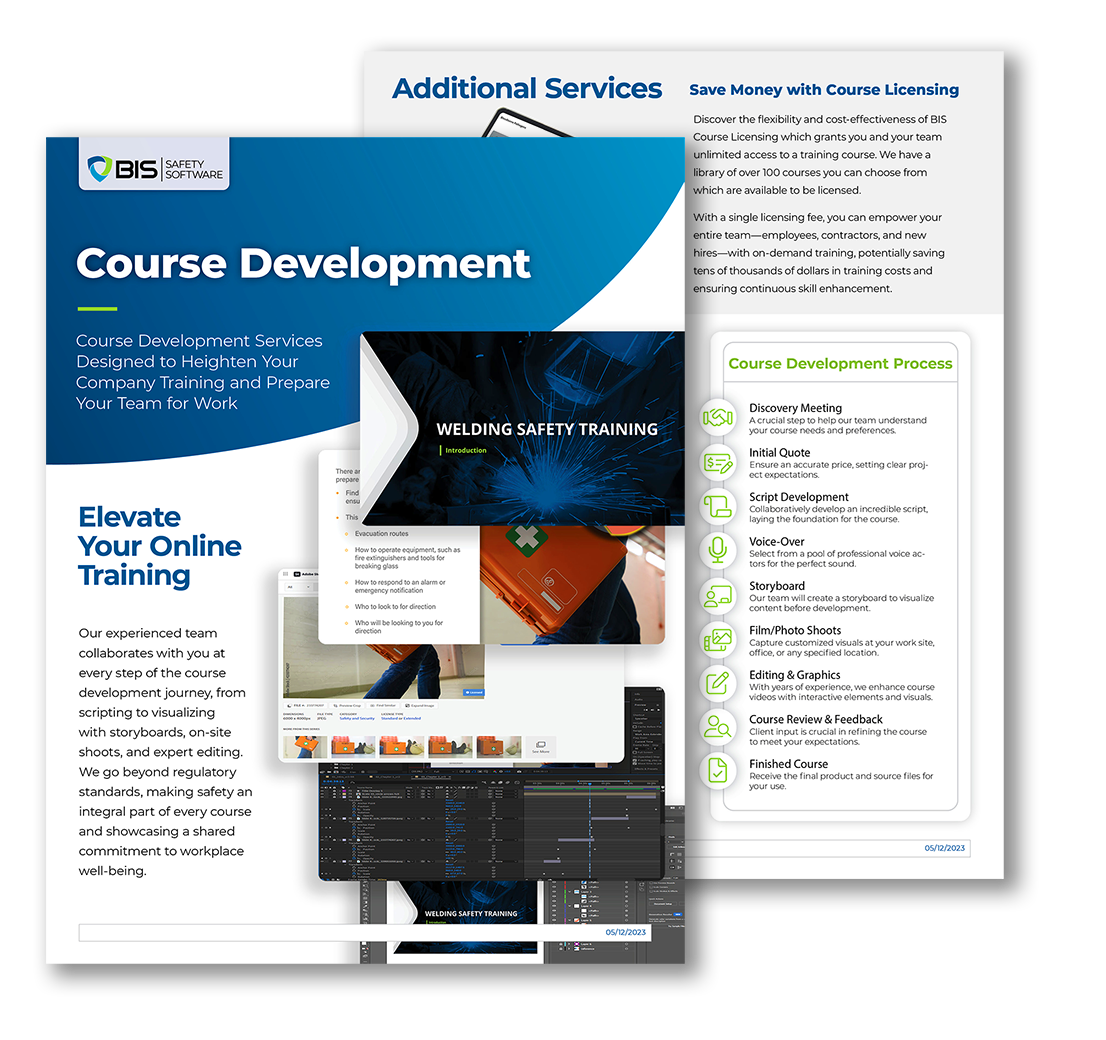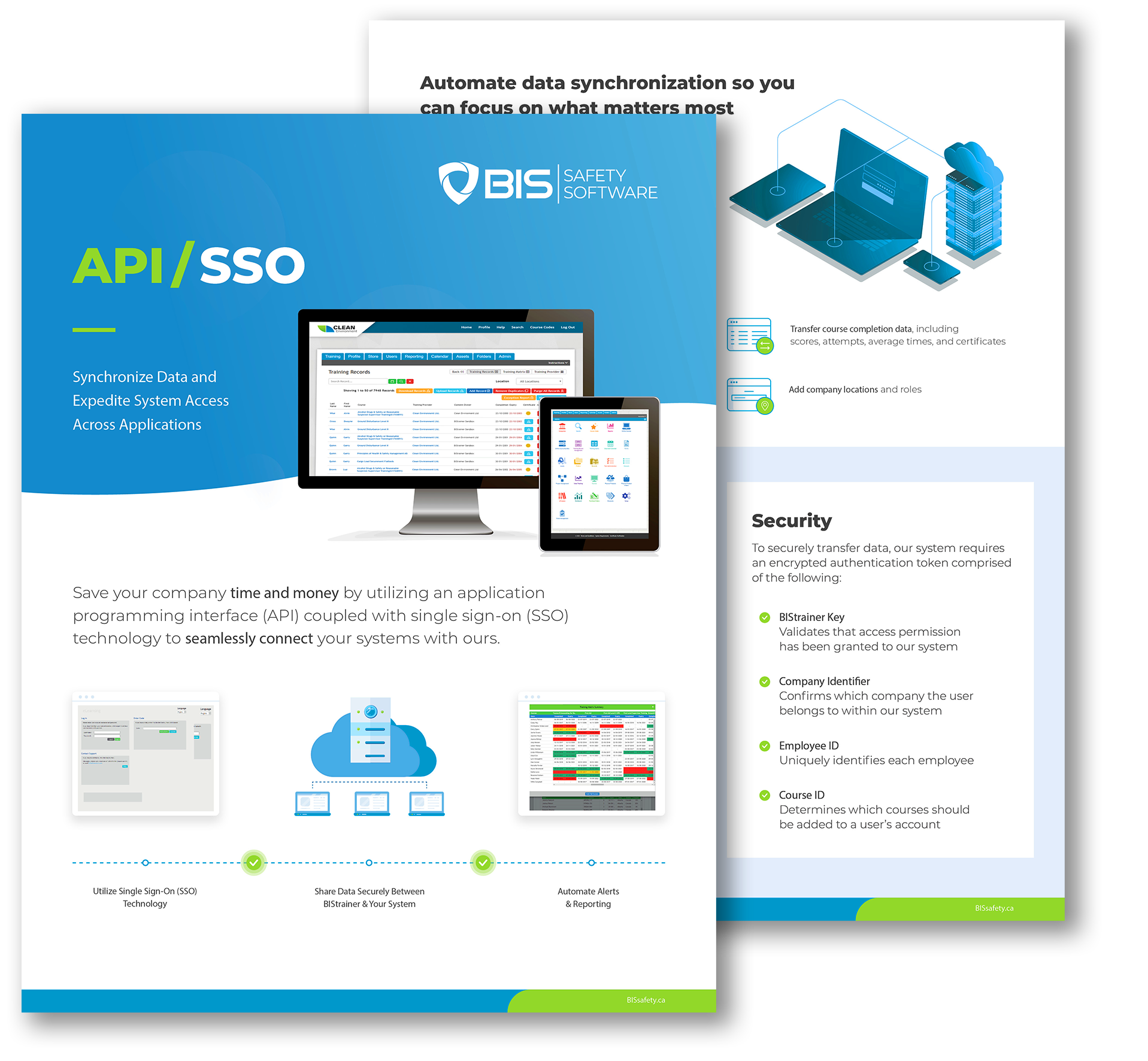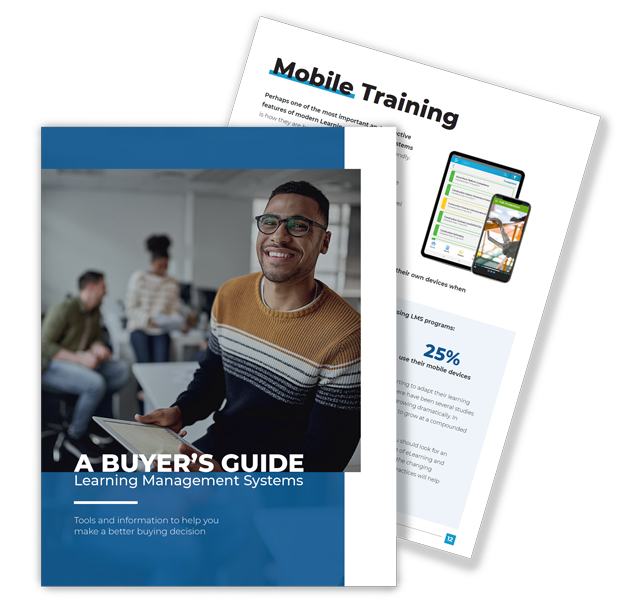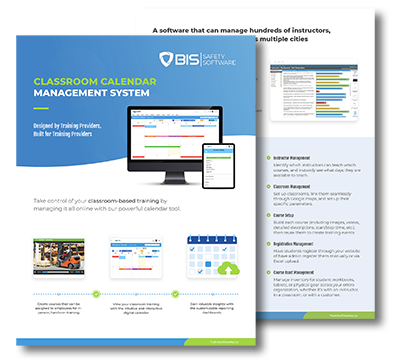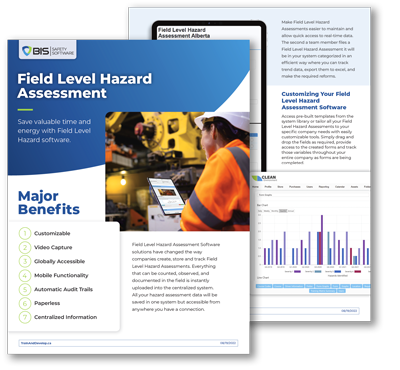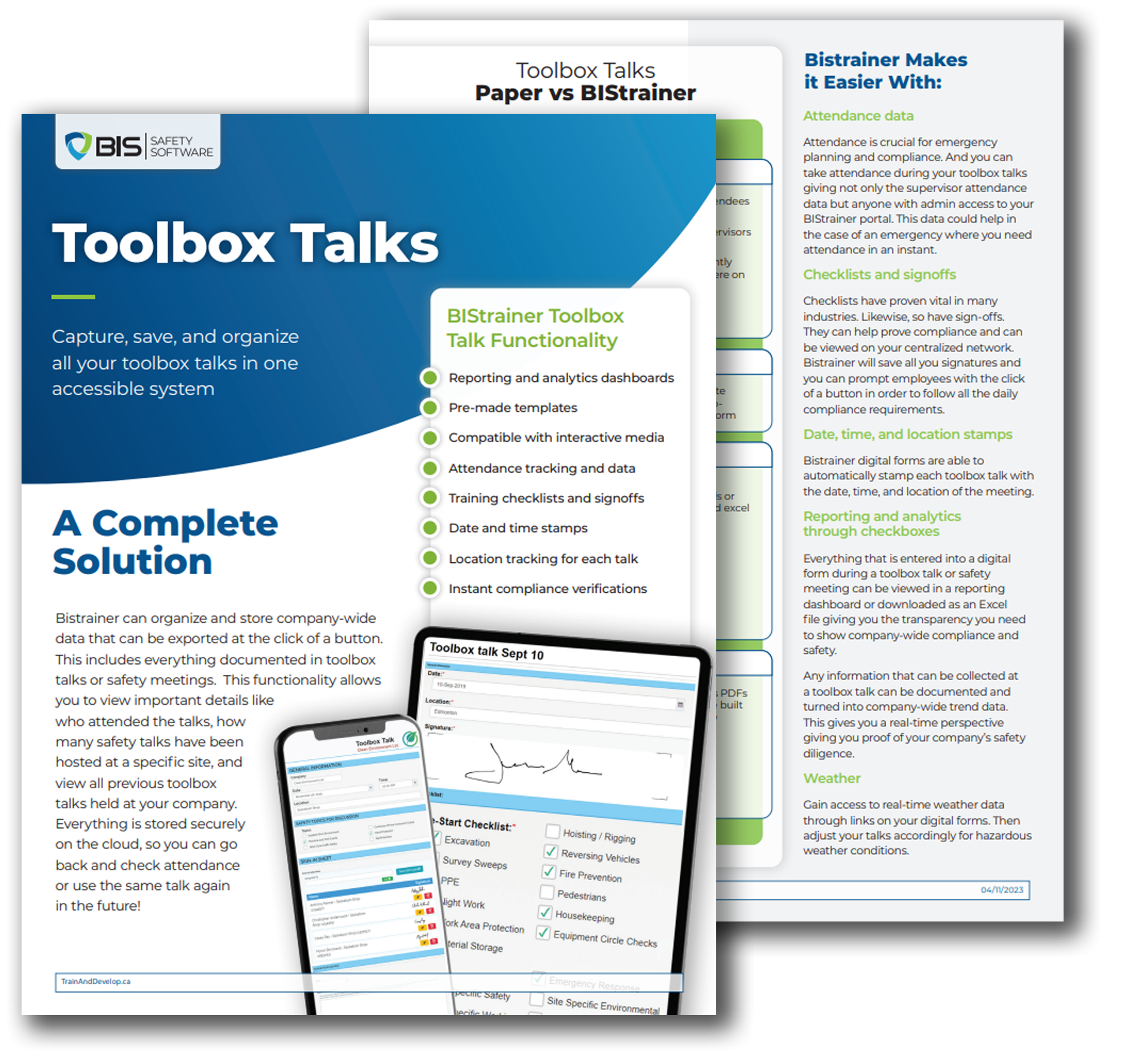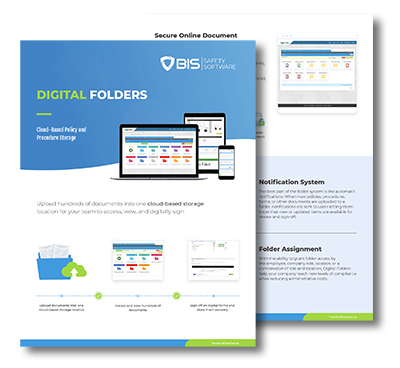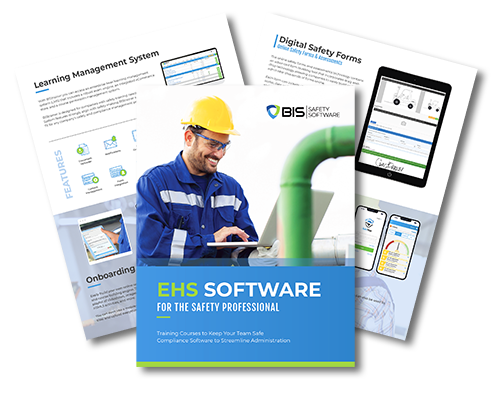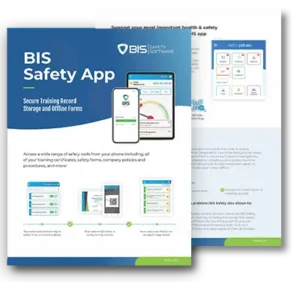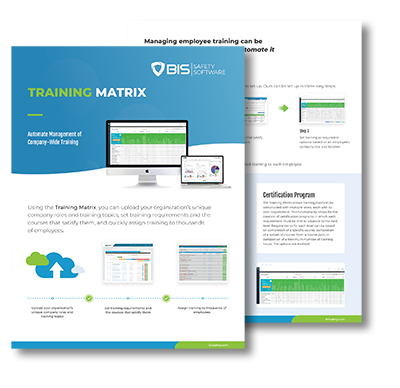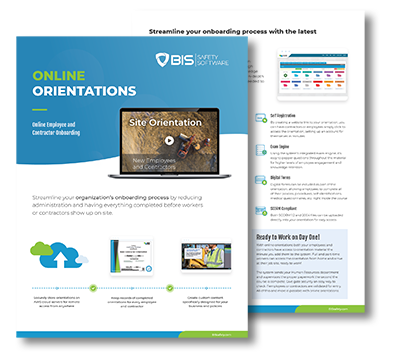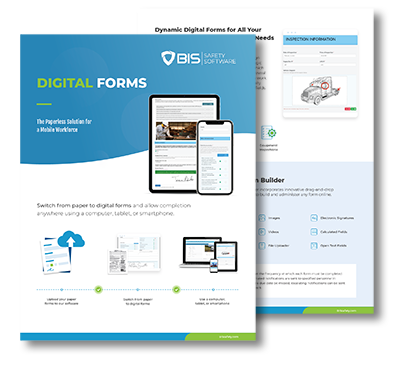Choosing the best Learning Management System (LMS) can make or break your training programs, employee development, and compliance initiatives. With countless options on the market, selecting the best fit is overwhelming. This guide breaks down critical factors to help you confidently navigate your options and choose a system that truly enhances your organization’s efficiency.
Why is this important? LMS platforms are designed with specific industries in mind, some are ideal for schools, while others are built for corporate training or industries like construction and mining. Choosing a system that doesn’t align with your industry’s needs might still work, but it won’t deliver the best results. The right LMS is one that’s tailored to your business, helping you maximize efficiency and create a more effective training environment.
For Canadian organizations, it’s crucial to ensure the LMS stores data on Canadian servers to
comply with local privacy laws, protecting your business from potential legal risks.
What Should You Look for in a Top lMS?
Critical Elements of an LMS
When choosing an LMS, these are some key elements to ensure a learning management system works for you.
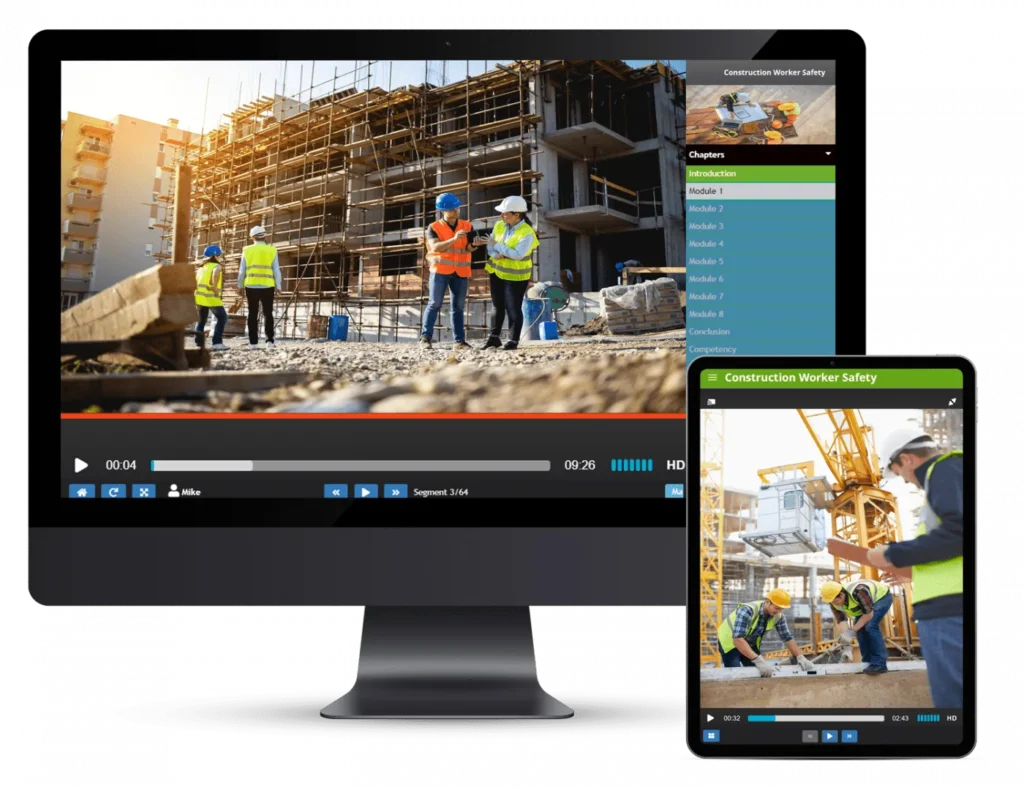
Ease of Use for Industries
An adaptable LMS offers a user-friendly, customizable platform suitable for industries like Energy and Transportation. Its simplicity, paired with robust access controls, lets businesses personalize training solutions while maintaining security and a smooth user experience. This enables effortless integration and effective management of training initiatives across multiple sectors.
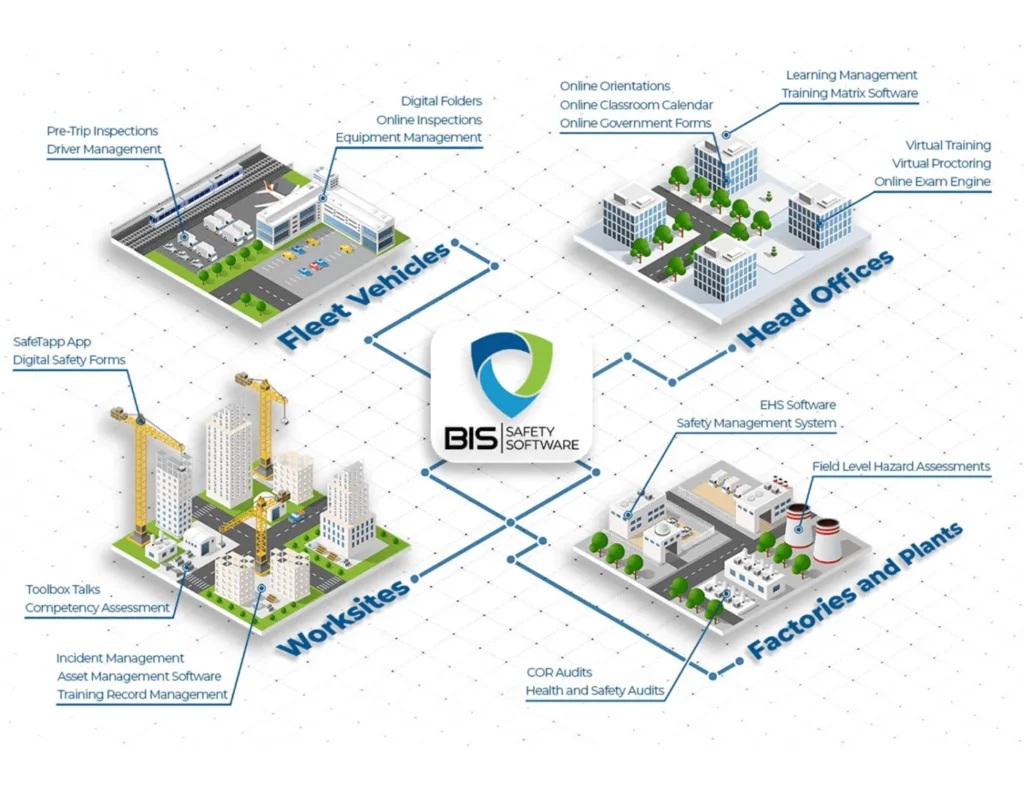
Scalability and Flexibility
Designed for growth, a scalable LMS can handle companies of any size, with flexible access management, API integration for user provisioning, and features like audit logs to track activities. This adaptability allows businesses to expand without compromising on performance or security as they grow.
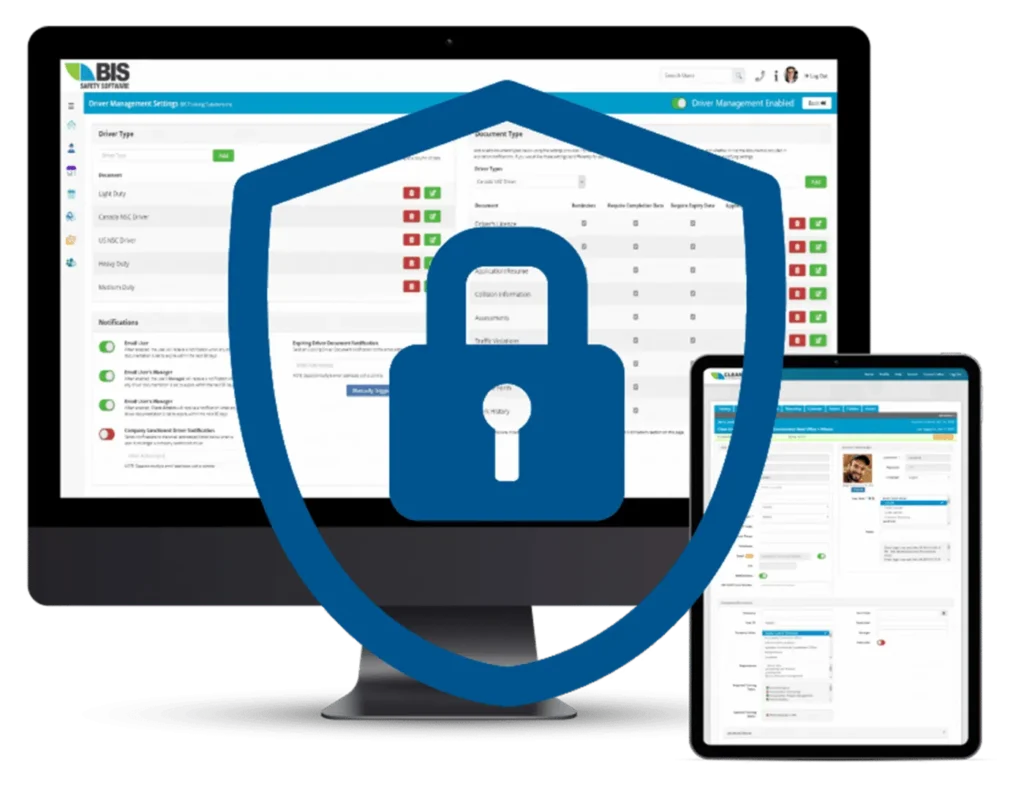
Security and Compliance
A reliable LMS guarantees data protection and compliance with key standards like SOC 2 and GDPR. Opt for systems with encryption for both in transit and at rest, safeguarding sensitive data. Role-based permissions and multi-factor authentication (MFA) further strengthen security by preventing unauthorized access.

Customer Support
A premium LMS offers round-the-clock, proactive customer support for onboarding, issue resolution, and routine maintenance. From monitoring vulnerabilities to managing essential updates, support teams ensure system stability and promptly handle concerns, keeping operations efficient and secure.
Key Considerations for Choosing an LMS
When selecting an LMS, it’s important to evaluate solutions based on your specific needs. Below are the key factors to consider when comparing platforms:
1. Ease of Use
Your LMS should be intuitive and easy to navigate, both for administrators and users. A complicated system can hinder adoption and decrease engagement.
▸ User-Friendly Interface
Ensure the system is easy to navigate for all users.
Tools like customizable dashboards or drag-and-drop interfaces can simplify the user experience.
▸ Mobile Accessibility
Personalize views for different roles and departments.
Dashboards can display relevant KPIs, course progress, or assigned tasks based on the user’s role.
▸ Customizable Dashboards
Verify LMS access on mobile devices.
Mobile-optimized interfaces or dedicated LMS apps help users access training anywhere.
▸ Minimal Training Required
Confirm quick onboarding for new users.
Tools like guided tutorials or built-in walkthroughs help reduce the learning curve for new users.
2. Integration Capabilities
The LMS you choose should integrate seamlessly with the software your organization already uses, whether it’s HR tools, CRM systems, or compliance software.
▸ API Avaliability
Verify the LMS integrates via APIs with HRIS, CRM.
APIs allow for seamless data flow between the LMS and other tools like payroll, HR software (e.g., BambooHR), or CRM systems (e.g., Salesforce).
▸ Third-Party Software Compatibility
Check for automated data synchronization across systems.
Integration with systems like Zoom for virtual training, or Google Workspace for document sharing, ensures compatibility.
▸ Data Sync Capabilities
Confirm compatibility with compliance tools or other third-party systems.
Automated sync with compliance management tools ensures that data is updated across platforms, such as in compliance reporting systems.
3. Scalability
As your business grows, your LMS needs to scale with it. Whether you’re adding more employees, locations, or departments, your LMS should accommodate growth without sacrificing performance.
▸ Supports Unlimited Users
Ensure the platform can scale with your user base.
A scalable database and cloud infrastructure allow the system to handle large volumes of users without performance degradation.
▸ Cloud-Based Hosting
Confirm the LMS uses cloud hosting for scalability.
Cloud solutions like Amazon Web Services (AWS) or Microsoft Azure provide flexible and scalable hosting.
▸ Multi-Tenant SaaS
Verify that data is securely segregated for multiple clients or departments.
Multi-tenant platforms allow for segregated databases, ensuring client-specific data security while supporting multiple organizations.
4. Feature Set
Make sure the LMS offers the features you need, such as course creation, tracking, compliance reporting, certifications, and mobile learning.
▸ Course Creation
Verify the ability to create custom courses.
Course authoring tools like SCORM or xAPI-compliant builders allow organizations to create personalized learning experiences.
▸ SCORM Compliance
Ensure the LMS supports SCORM standards for content.
SCORM and xAPI compatibility enable easy import of existing eLearning content.
▸ Comprehensive Reporting
Check that the system generates detailed reports.
Reporting features should include customizable reports on learner progress, compliance status, and certifications.
▸ Compliance Tracking
5. Cost and ROI
▸ Transparent Pricing
Confirm detailed, transparent pricing models.
Look for clear pricing structures such as subscription models or pay-per-user fees.
▸ Time and Cost Savings
Calculate how much time and money automation can save.
Features like automated compliance reminders, digital forms, or exam grading help reduce the manual workload.
▸ Automated Reporting
Verify the LMS saves time on manual reporting.
Automated reports for training completion, employee progress, and compliance status save hours on manual tracking.
6. Customer Support
An LMS is only as good as the support behind it. Make sure your provider offers fast, reliable customer service and onboarding assistance.
▸ 24/7 Support Availability
Ensure round-the-clock support is provided.
Chatbots, live chat, or ticketing systems ensure users get help when they need it.
▸ Dedicated Onboarding Help
Confirm dedicated help during setup.
Onboarding tools, such as video tutorials or dedicated support agents, can make the implementation process smoother.
▸ Self-Help Resources
Verify access to a knowledge base and tutorials.
An extensive knowledge base with FAQs, how-to articles, and video tutorials can empower users to troubleshoot issues on their own.
7. Security and Compliance
Security should be a top priority, especially if your LMS stores sensitive employee or company data. It should also help you stay compliant with industry standards.
▸ Data Encryption (AES 256)
Ensure data is encrypted at rest and in transit.
Encryption protocols like AES 256 ensure data security while being transferred or stored.
▸ SOC 2 and GDPR Compliance
Verify compliance with industry standards like SOC 2 and GDPR.
Security certifications, audit logs, and privacy tools help maintain regulatory compliance.
▸ Audit Logs
Confirm that all user activities are tracked for compliance.
Audit logs track user activity, such as course completions and data changes, ensuring transparency and accountability.
▸ Role-Based Access Control
Check that access is restricted based on user roles.
Role-based access controls allow admin users to assign permissions based on roles, ensuring secure access to sensitive data.
Now that you know what to look for, what are…
The Best Learning Management Systems
- Adobe Learning Manager (US): Seamless integration with Adobe Creative Cloud
- TalentLMS (US): Ideal for small businesses
- BIS Safety Software (Can): Strong in safety compliance and workforce training
- Absorb (Can): Great for learning management in classrooms
- iSpring (US): Recognized for being a great small starter company option
- Docebo (Can): Preferred by large corporations
- D2L Brightspace LMS (Can): Popular with educators
- Blackboard Learn LMS (US): Favoured by higher education institutions
- Canvas LMS (US): Widely used by Ivy League schools
- Moodle LMS (Aus): Good for non-profits and is an excellent open-source platform
Wrapping Up
Choosing the right LMS is critical to ensuring your organization’s training, compliance, and onboarding processes run smoothly. A well-designed LMS should offer the tools you need to manage, track, and deliver training effectively, while providing the flexibility to grow with your business. With the right system in place, you can improve efficiency, ensure regulatory compliance, and empower your employees to succeed.
Related Articles
- All Posts
- #EmergencyPreparedness
- 2025 safety trends
- 360 Immersive
- 360immersive
- 6S Safety
- accident prevention
- accidental careers
- accountability
- adjustable workstations
- adult education
- AFAD
- AI automation
- AI implementation
- AI in business
- AI in operations
- AI in Safety
- AI podcast
- AI strategy
- AI transformation
- Alberta safety
- Alberta safety courses
- Allan James Moore
- Anhydrous Ammonia
- artificial intelligence
- asking for help
- audit findings
- audit readiness
- Audit Reporting
- automation in safety
- automation strategy
- avoidable injuries
- awareness
- Aztec Safety
- back strain
- BambooHR integration
- Bear safety
- behavior-based safety
- Behavioral Safety
- behavioural safety
- biometric sensors
- BIS Podcast
- BIS Safety Podcasts
- BIS Safety Software
- BIS Safety Spotlight
- black holes
- Blame Culture
- Blue Angels
- BP Texas City Explosion
- Brave Leadership
- Brett Burkard
- bump test
- burnout
- business automation
- calibration
- call before you dig
- Canadian OHS
- Canadian safety
- Canadian safety history
- Canadian Safety Regulations
- Canadian safety standards
- Canadian wilderness safety
- carbon monoxide
- Cargo Securement
- Carolynne Heron
- CCOHS
- chemical
- Chemical Safety
- chemical vapors
- chronic injuries
- chronic pain
- cloud-based safety tools
- Coming Soon
- Commercial Vehicle Safety
- Communication Systems
- community safety programs
- Competency in Safety
- complacency in safety
- Compliance
- compliance courses
- Compliance In Canada
- compliance issues
- Compliance management
- Compliance Reporting
- compliance software
- compliance tools
- compliance tracking
- compliance training
- compliance vs protection
- confined space
- Confined Space Safety
- Construction advocacy
- Construction education
- Construction industry
- construction safety
- construction safety training
- construction technology
- continuous improvement
- continuous safety improvement
- corporate culture
- corporate training
- corrective actions
- CPR and AED
- crane
- CSA standards
- Customer Spotlight
- Customer Spotlight Kevin Swinden Global Hazmat Safety Culture Hazmat Management Dangerous Goods Competency in Safety Workplace Risk Mitigation BIS Training Clients Canadian EHS
- customized training
- daily trip inspection
- Damage Prevention
- Dangerous Goods
- dangerous goods classification
- Danny Sellers
- data-driven safety
- debriefing
- Decision Analysis
- Decision quality
- defect management
- defect tracking
- defensive driving
- DEI in onboarding
- digital badges
- digital compliance
- digital FLHA
- digital forms
- Digital Hazard Reporting
- Digital Onboarding
- digital safety
- Digital Safety Audits
- digital safety meetings
- Digital Safety Solutions
- Digital safety systems
- digital safety tools
- digital safety transformation
- digital site access
- Digital Training Tools
- digital transformation
- DMS features
- document control
- document management system
- Dr. Joanna Pagonis
- Dr. Tom Krause
- driver file management
- driver training
- driving instructor program
- DTRMS
- e-learning
- e-learning tools
- eadership in safety
- early intervention
- education technology
- EHS
- EHS Adoption
- EHS Compliance
- EHS digital solutions
- EHS Inspections
- EHS Onboarding
- EHS software
- EHS Strategy
- EHS systems
- EHS technology
- EHS tools
- Einstein
- electrical safety
- elite performance
- Emergency Action Plan
- emergency preparedness
- emergency procedures
- emergency response
- emergency supplies
- emotional training
- employee behavior
- employee engagement
- employee health
- Employee onboarding
- employee preparedness
- Employee Readiness
- employee safety
- employee training
- employee trust
- Employee Well-Being
- Employer Responsibilities
- Energy Isolation
- engaging toolbox meetings
- equipment inspections
- ergonomic consulting
- ergonomic design
- ergonomic risks
- ergonomics
- Evacuation Procedures
- evidence collection
- EWI Works
- excavator safety essentials
- exoskeleton
- exoskeletons
- failure analysis
- fall prevention
- fall protection
- fast onboarding
- field experience
- field level hazard assessments
- field operations
- field safety
- field safety assessments
- field safety communication
- field safety leadership
- field safety services
- Field Safety Technology
- field safety tools
- Field-Friendly Software
- Fire Drills
- fire prevention
- Fire Safety Training
- first aid
- first aid kit
- first week on the job
- first workplace injury
- flaggers
- Fleet Compliance
- fleet management
- fleet safety
- FLHA engagement
- FLHA Integration
- FLHA software
- floor mats
- FMEA
- freight
- Frontline Engagement
- frontline safety
- fuel handling
- future of work
- gas detection
- gas monitors
- Gas Safety
- Global Hazmat
- global onboarding
- Good Samaritan laws
- gravitational waves
- gut feeling in safety
- hand injuries
- handling hazardous materials
- hands-on training
- hazard analysis
- hazard assessment compliance
- hazard assessment software
- Hazard Awareness
- hazard communication
- Hazard Control
- Hazard Identification
- hazard prevention
- hazard recognition
- hazard reporting
- hazard reporting technology
- hazard tracking
- Hazardous Energy Control
- Hazardous Materials
- Hazmat Management
- Health & Safety Podcast
- health and safety
- hearing loss prevention
- hearing protection
- heavy equipment operation
- heavy equipment safety
- hidden workplace hazards
- high voltage systems
- High‑performance teams
- HR automation
- HR software
- HR technology
- human factors
- human factors in safety
- human in the loop
- Human Performance
- human vs machine
- human-centered design
- human-centered safety
- Humble leadership
- humor in safety
- hydrogen sulfide
- ICBC certification
- ice melt
- identification
- immersive learning
- Imposter Syndrome
- incident data
- incident investigation
- incident management
- incident prevention
- incident reporting
- inclusive leadership
- industrial AI
- Industrial Hygiene
- industrial safety
- Industrial Training
- influence vs control
- Infrastructure Risk
- injury consequences
- injury prevention
- injury prevention tips
- injury recovery
- injury reporting
- injury response
- injury response plan
- inspections
- instant hazard logging
- instructor development
- internal audits
- international workforce
- interpreting safety data
- invisible dangers
- ISO standards
- Jeff Mulligan
- Jennifer Lastra
- job site accountability
- job site hazards
- job site risks
- job site safety
- jobsite readiness
- Jody Young
- KBR Safety Training
- Kevin Swinden
- labor movement
- ladder safety
- Leadership
- leadership accountability
- leadership and empathy
- Leadership by example
- Leadership Development
- Leadership in Safety
- Leadership Management
- leadership messaging
- Leadership trust
- Lean Manufacturing
- Lean Workplace
- learning from incidents
- learning management
- lifting techniques
- lighting
- LIGO
- Linda Miller
- LMS
- LMS features
- LMS software
- Load Securement
- Lock Out Tag Out
- lockout tagout
- Lone Worker Safety
- lone workers
- LOTO
- LOTO Training
- machine learning
- Machine Safety
- Maintenance Safety
- mental health at work
- MI Safety
- microlearning
- Mike Schwartz
- minor injuries
- mobile FLHA solution
- mobile onboarding
- Mobile Safety Apps
- Mobile Safety Platforms
- mobile safety reporting
- Mobile Safety Tools
- mobile safety tools safety compliance solutions
- MOU Standards
- mould hazards
- mould prevention
- movement in workplace
- Multi-Contractor Worksites
- multilingual training
- MyZone AI
- Near Miss Reporting
- new hire experience
- New Hire Safety
- New Worker Training
- new workers
- no-blame investigations
- noise exposure
- nonconformance
- Northern BC
- NRCA
- NSC Standard 13
- occupational fatigue
- occupational hazards
- occupational health
- Occupational Health and Safety
- Occupational Health and Safety (OHS)
- occupational health risks
- occupational safety
- occupational therapy
- OH&S
- OHS
- OHSA
- oil and gas safety
- omni-training
- On-Site Safety
- onboarding Canada
- onboarding safety
- Onboarding Software
- online learning
- online orientation software
- Online safety training
- operational efficiency
- Operational Excellence
- Operational risk
- organizational culture
- organizational safety
- OSHA compliance
- OSHA standards
- outdated practices
- Outdoor work hazards
- overconfidence
- overhead crane courses
- pain awareness
- paperless safety reporting
- paperless safety talks
- personal protective equipment
- Pharmaceutical Safety
- physics careers
- pipeline safety
- playbook software
- podcast
- post-accident review
- post-incident protocol
- PPE
- PPE enforcement
- PPE improvement
- pre-trip inspection
- predictive analytics
- pretrip inspection
- preventing shortcuts
- preventive action
- proactive risk management
- proactive safety
- proactive safety culture
- proactive safety measures.
- Proactive Safety Systems
- process improvement
- Professional development
- propane safety
- propane storage
- protective clothing
- psychological hazards
- psychological safety
- quality control
- quality management
- quality standard
- Real Safety Leadership
- real-time hazard reporting
- Real-Time Reporting
- real-time safety
- real-time safety tools
- real-time site data
- recordkeeping
- reduce training costs
- regulatory updates
- repetition in safety
- repetitive motion injuries
- respirator safety
- respirators
- risk assessment
- risk management
- risk mitigation
- risk prevention
- Risk Prevention Tools
- risk reduction
- road safety
- Robin Postnikoff
- ROI with AI
- root cause analysis
- root cause correction
- routine task risks
- safe excavation
- safe habits
- safe transport
- safe work habits
- safe work practices
- safety
- safety accountability
- safety advice
- safety article
- Safety Audit Software
- safety automation
- safety awareness
- safety best practices
- safety communication
- safety compliance
- Safety Conversations
- safety culture
- safety data
- safety data sheets
- safety documentation
- safety engagement
- safety follow-up
- safety gear
- safety gloves
- safety goggles
- safety habits
- safety improvement
- safety incentives
- safety innovation
- safety insights
- safety inspection
- safety instinct
- Safety Leaders
- safety leadership
- Safety Leadership Podcast
- safety legislation
- safety lessons
- safety management
- safety management system
- safety management systems
- safety metrics
- safety mindset
- safety motivation.
- safety myths
- safety onboarding
- safety planning
- safety podcast
- safety procedure updates
- Safety Procedures
- safety process improvement
- safety professionals
- safety reporting
- safety review process
- safety shortcuts
- safety software
- Safety Spotlight
- Safety strategy
- safety systems
- safety technology
- safety theater
- safety tips
- safety tools
- safety training
- safety transformation
- safety transparency
- Sarah Anderson
- scaffold safety
- scaffolding inspections
- scalable training solutions
- Scott Lyall
- shipping documentation
- silent dangers
- silica dust
- Sinogap Solutions
- slips trips falls
- slow-building hazards
- smart helmets
- smart PPE
- smart safety systems
- smart safety tools
- Social Learning
- SOPs
- space science
- Spencer McDonald
- Standardized Work
- stop work authority
- storytelling and safety
- storytelling in safety
- supervisor training
- system safety
- Systems Thinking in Safety
- tablet-based toolbox talks
- TCP safety
- TDG
- team communication
- team performance
- teamwork
- tech and ergonomics
- tech in safety
- tech-enabled learning
- Thinking Driver
- Titan Environmental
- Tom Krause
- toolbox talks tablets
- Total Recordable Injury Formula
- tough guy mentality
- toxic air
- traction control
- traffic control
- traffic control plan
- training
- training courses
- Training integration
- training management
- training matrix
- training record management
- training records
- training software
- transportation
- transportation of dangerous goods
- Transportation Regulations
- Transportation Safety
- Trucking Regulations
- trust
- Trust and Accountability
- trust at work
- Underground infrastructure
- underground utilities
- unseen workplace threats
- Upward communication
- user experience
- utility line marking
- utility locating
- Utility safety
- Utility Safety Partners
- values-based onboarding
- vehicle safety
- version control
- veteran advice
- Virtual Reality
- VR safety training
- VR Technology
- walkway maintenance
- wearable technology
- Weights and Dimensions
- WHMIS
- Wildlife awareness
- winter safety
- witness statements
- women in leadership
- work zone safety
- work-alone training
- work-related injuries
- worker accountability
- worker advocacy
- worker fatigue
- worker protection
- worker safety
- worker safety habits
- worker safety tips
- worker trust
- worker wellbeing
- workers' rights
- Workforce Automation
- workforce compliance
- Workforce development
- workforce engagement
- workforce management
- Workforce Readiness
- workforce training
- Working Alone Canada
- workplace accidents
- workplace air quality
- workplace best practices
- workplace certification
- workplace compliance
- Workplace Culture
- workplace hazard prevention
- Workplace Hazard Tracking
- workplace hazards
- workplace health
- workplace incident response
- workplace injuries
- workplace injury prevention
- workplace inspections
- workplace leadership
- workplace mindset
- Workplace Organization
- workplace readiness
- workplace risk factors
- workplace risk management
- Workplace Risk Mitigation
- Workplace safety
- Workplace Safety Compliance
- workplace safety culture
- Workplace Safety Leadership
- workplace safety rules
- workplace safety tech
- workplace safety tips
- Workplace Safety Tools
- workplace safety training
- workplace stress
- workplace tiredness
- workplace wellness
- WSPS

Choosing the best EHS software isn’t just a tech choice, it’s a strategic decision that shapes safety culture, compliance, and...

Spring brings fast growth and serious mowing hazards. This guide highlights why seasonal lawnmower safety training matters, helping crews inspect...

In this episode of Safety Spotlight, Jake walks through his winding path from volunteer firefighter and EMT, to Army paratrooper,...




